
Housing
Strategic Plan
FINAL REPORT Root Policy Research
5/22/2024 6740 E. Colfax Avenue, Denver, CO 80220
www.rootpolicy.com
970.880.1415

ARVADA HOUSING STRATEGIC PLAN
ROOT POLICY RESEARCH ARVADA HOUSING STRATEGIC PLAN, PAGE 1
INTRODUCTION
This Housing Strategic Plan identifies, prioritizes, and
recommends housing goals, policies, programs and resources
to address housing needs in the City of Arvada. The Plan builds
on Arvada’s 2020 Housing Needs Assessment and Strategy,
accounting for changes in market trends, state resources, and
the progress made on the 2020 Housing Plan.
The goals and strategies outlined in this Plan were informed by
a Comprehensive Housing Needs Assessment (see Appendix A);
input from residents, in-commuters, and stakeholders (also in
Appendix A); as well as direction from City staff and the Housing
Advisory Committee (HAC). Strategic Actions are informed by
Root Policy Research’s expertise and experience in peer
communities and best practices in housing policy.
REPORT ORGANIZATION
Following a one-page executive summary, the Strategic Plan is
organized around the following sections:
Why Work to Address Housing Needs?
Summary of Housing Needs and Community Engagement (for
details, see Appendix A. Housing Needs Assessment, HNA).
Progress on Action Items in the 2020 Housing Strategy.
Housing Goals and Strategy Framework.
2024 Housing Strategies and Actions.
ACKNOWLEDGEMENTS
Special thanks to the City’s Housing Preservation and
Resources Division and the Arvada Housing Authority staff—
particularly Samantha Bradley and Carrie Espinosa—and to the
HAC for their continued work and input on development of the
Plan; and to the numerous residents and stakeholders who
participated in engagement opportunities to inform the
Housing Needs Assessment and Strategic Plan.
HUD AMI: Housing programs rely on income limits
published by the U.S. Department of Housing and Urban
Development (HUD) that are represented as percentages of the
area median family income (commonly abbreviated as “HUD
AMI” or simply “AMI”). Common programmatic income
qualifications occur at 30% AMI, 50% AMI, 60% AMI, and 80%
AMI. The 2023 AMI for a 2-person household in Arvada is
$99,300. See Appendix A (HNA) for additional details on how
AMI is determined and the current AMI thresholds in Arvada.
Housing Advisory Committee Members:
Paul Bunyard Tim Rogers
Andrew Heesacker Cmbr. Lisa Feret
Roger Jones Matthew Wedell
Mindy Mohr Harrison Wilterdink
Patrick Noonan

EXECUTIVE SUMMARY OF STRATEGIC PLAN
ROOT POLICY RESEARCH ARVADA HOUSING STRATEGIC PLAN, PAGE 2
OVERVIEW OF RECOMMENDED STRATEGIES
The Arvada Housing Strategic Plan policy levers, strategies, and priorities are summarized below. Strategies and action items were
developed in conjunction with Arvada City staff, City Council, and the Arvada Housing Advisory Committee (HAC) and are grounded
in evidence-based
best practices, Root
Policy Research’s
expertise, and input
from Arvada
residents and
stakeholders as part
of the community
engagement
conducted in support
of the Housing Needs
Assessment and
Strategic Plan.
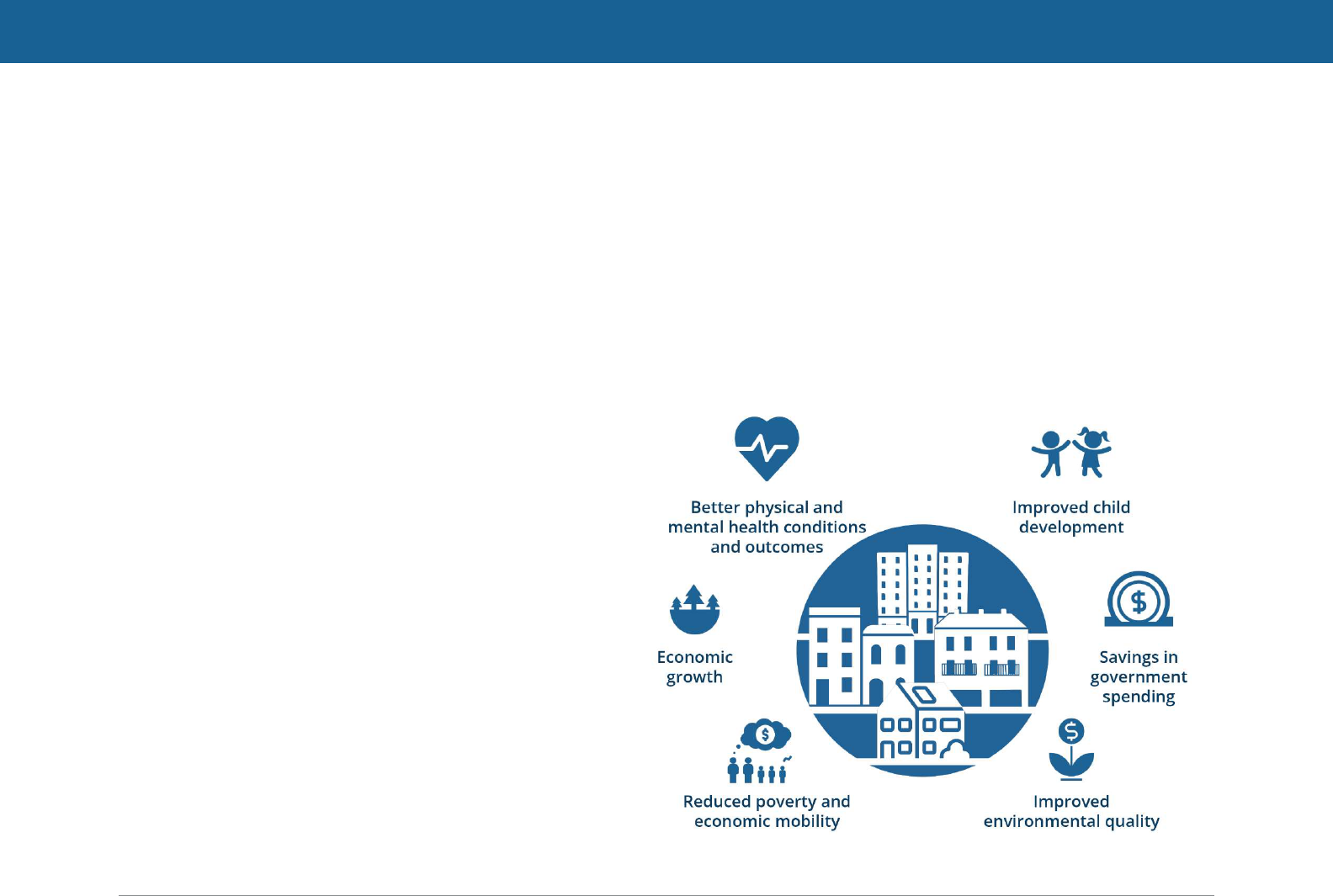
WHY WORK TO ADDRESS HOUSING NEEDS?
COMMUNITY INPUT
ROOT POLICY RESEARCH ARVADA HOUSING STRATEGIC PLAN, PAGE 4
A balanced housing stock accommodates a full “life cycle community”—where there are affordable
housing options for each stage of life from career starters through centenarians—which in turn
supports the local economy and contributes to Arvada’s community culture.
Research consistently shows that a constrained housing
market negatively impacts economic growth while
stable and affordable housing are central to the health
of individuals, families, and communities.
Households living in stable housing are more likely to
spend their incomes in the local economy through
direct spending on goods and services.
Housing investments that allow workers to live near
their place of employment can reduce the impacts of
traffic and commuting, and attract new business by
increasing recruitment of talent, productivity and retention
of the talent that is recruited.
Affordable housing is key to providing high quality
public services as many essential workers (e.g., first
responders, medical professionals, and teachers) often
leave communities that do not have an adequate supply
of housing in their price range.
Affordable housing also plays a key role in preventing
and resolving homelessness.
Generational wealth from affordable home ownership
is a major contributor to positive outcomes for children.
As housing and equity are passed down, young adults
have the option to remain in the community and have families
of their own.
Housing investments and stable housing environments also
bolster local revenue, increase job readiness, help renters
transition to homeownership, lower public costs of eviction and
foreclosure, and increase the economic and educational
opportunities for children.
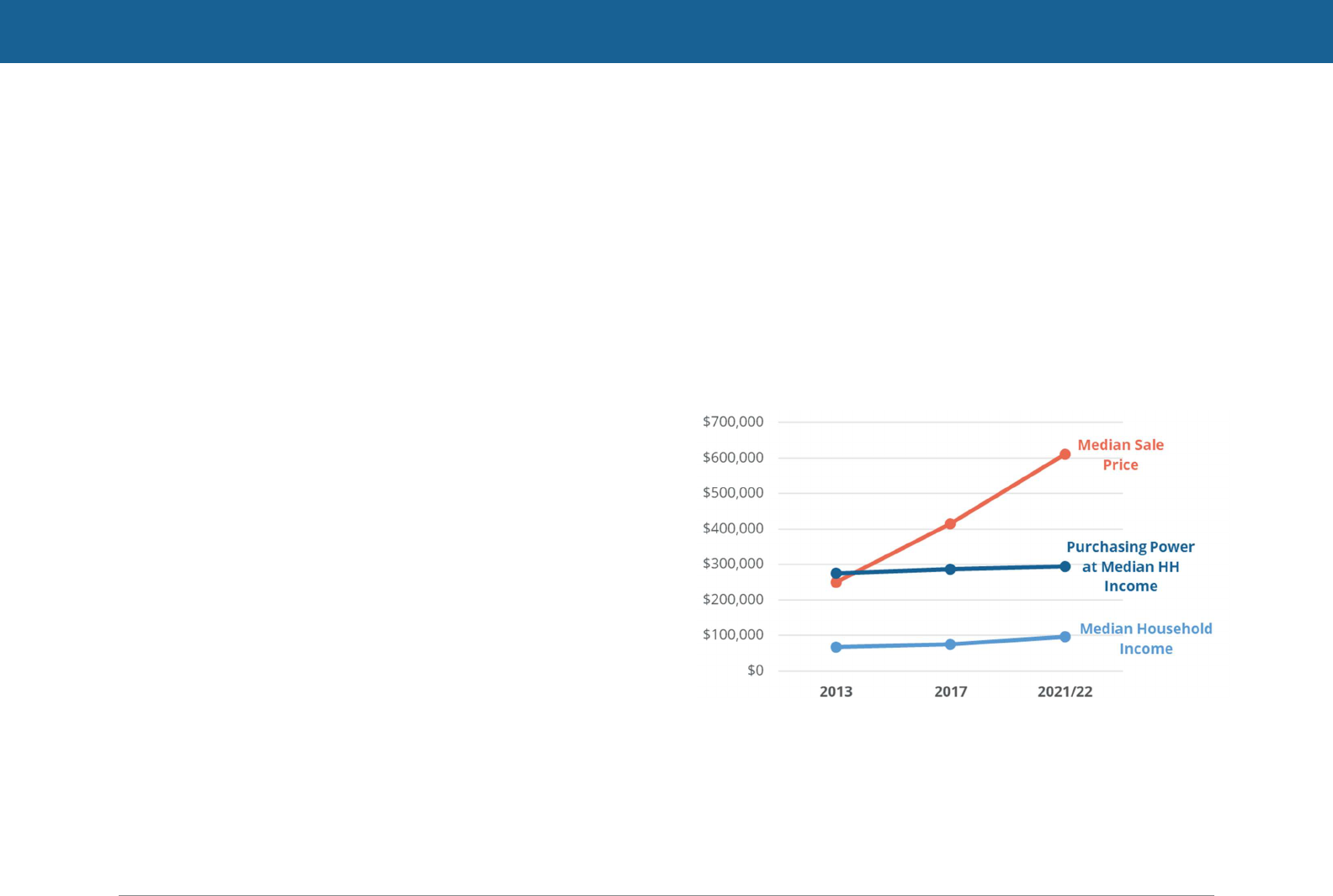
SUMMARY OF HOUSING NEEDS & COMMUNITY INPUT
ROOT POLICY RESEARCH ARVADA HOUSING STRATEGIC PLAN, PAGE 4
This section summarizes the key findings of the comprehensive
Housing Needs Assessment (HNA) and associated community
engagement efforts. The full HNA is included in Appendix A and
includes a demographic and economic profile of Arvada,
housing market trends, a housing needs analysis and full
results from the resident and in-commuter survey along with
stakeholder interviews and focus groups.
SUPPLY AND MARKET TRENDS
Housing supply. Arvada’s housing supply did not quite
keep pace with household and population growth over the past
5 years. Arvada’s current housing stock is weighted toward
single-family detached products (71% of all units). Production
of “missing middle” types (e.g., townhomes, and du-/tri-/quad-
plexes) is increasing but still constitutes a small share of sales.
Rental market. Median rents in Arvada were around $1,600
in 2021, 56% higher than median rent in 2013. Rental units in
the city have increasingly shifted to higher price points over the
last decade, resulting in a sharp decline in units affordable to
low- and middle-income households. Limited supply and low
vacancy rates contribute to an extremely tight market.
Homeownership. 75% of households own their home in
Arvada; this is a similar proportion to Jefferson County overall.
However, recent data on mortgage applications in Arvada show
that buying a home is increasingly out of reach for low- and
even moderate-income households. Arvada households now
need an income of $199,000 to afford the median price of
$606,000. Condos offer the most affordable option with a
median price around $350,000, but account for a relatively
small proportion of total sales (8%).
CHANGES IN AFFORDABILITY
The rise in home prices substantially outpaced incomes over
the past five years. These trends coupled with rising interest
rates are pushing homeownership further out of reach for
many current and potential future Arvada households, making
it difficult for renters to transition into home ownership, and for
those who work in Arvada to gain access to stable housing
For-Sale Market Affordability, Arvada, 2013-2021/22
Notes: Purchasing power assumes that buyers spend 30% of their income on housing and
have a 30-year mortgage with a 10% down payment. Ancillary costs (e.g., property taxes,
insurance, HOA payments) are assumed to collectively account for 30% of monthly housing costs.
Source: 2013, 2017, and 2021 ACS 5 year, Zonda Sales Data, and Root Policy Research.
The median home price rose 144% between 2013 and 2021, far
exceeding the change in median income (42%). Rising interest
rates exacerbate these changes and compress affordability
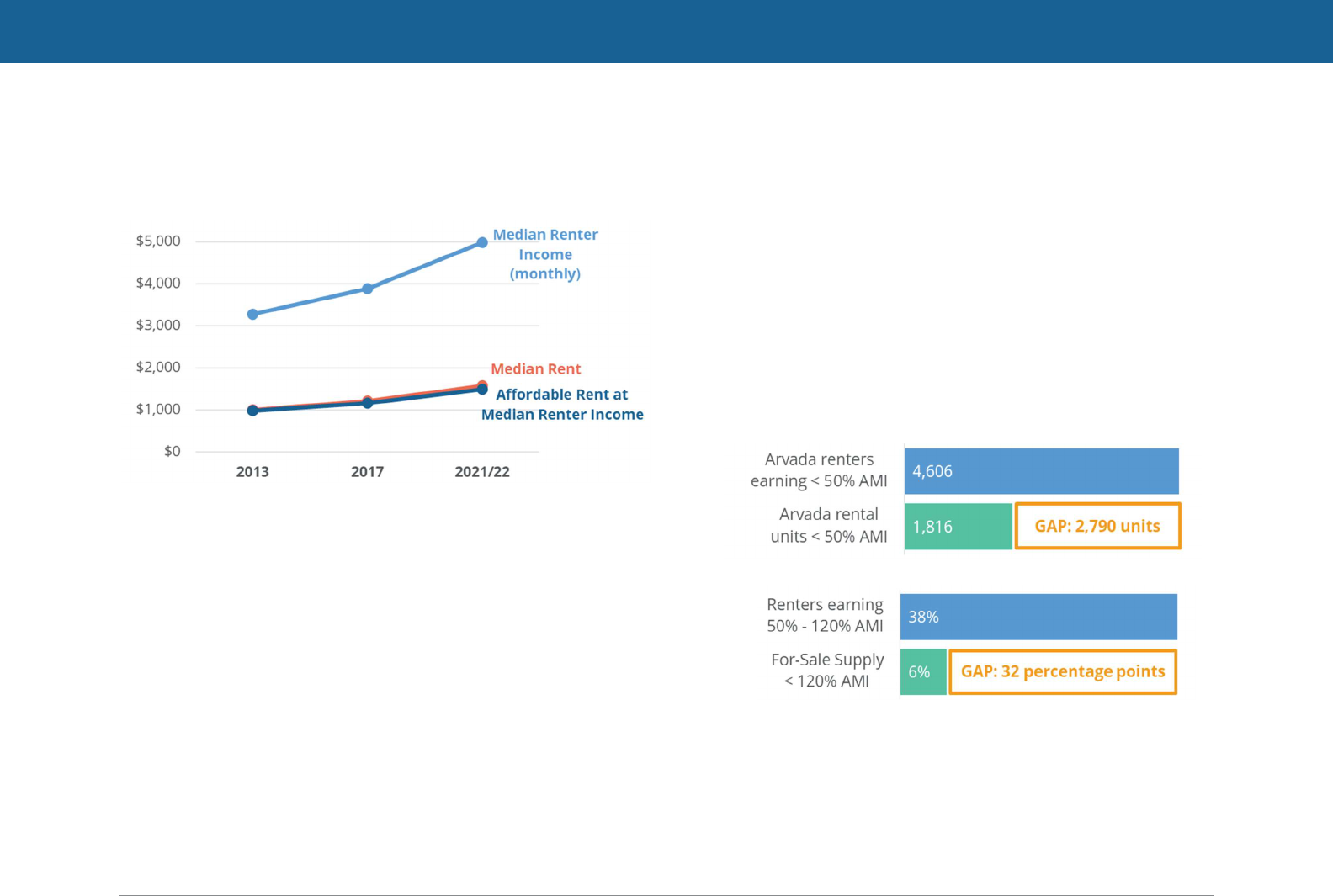
SUMMARY OF HOUSING NEEDS & COMMUNITY INPUT
ROOT POLICY RESEARCH ARVADA HOUSING STRATEGIC PLAN, PAGE 5
further: the change in purchasing power associated with rising
incomes was only 7%, due to the sharp spike in interest rates
over the period.
Rental Market Affordability, Arvada, 2013-2021/22
Source: 2013, 2017, and 2021 ACS 5 year , and Root Policy Research.
At the median, the increase in renter income and rental costs
were roughly proportional (52% rise in income and 56% rise in
rent). In other words—the median renter was almost able to
keep up with rising rents.
Even so, over half of Arvada’s renters are cost burdened
(spending 30% or more of gross income on housing). This leads
to housing instability, difficulties saving for a downpayment or
an emergency fund, and, overall, less disposable income
available to be spent at local businesses. Over the past 10 years,
cost burden has started to impact higher-income renters with
substantial increases in the proportion of renters earning
$35,000 to $75,000 that are cost burdened.
Affordable inventory. Income-restricted housing units play
an important role in providing affordable rents to Arvada
residents and workers with low to moderate household incomes.
Arvada currently has a total of 1,400 income restricted units across
24 properties, though some are at the end of their mandatory
affordability periods, with another 750 units in the pipeline.
Affordability Gaps—mismatches in supply and
demand by price-point. The affordability gaps analysis
indicates that affordability needs are concentrated below 50% AMI
in the rental market and below 120% AMI in the for-sale market
(though for-sale inventory needs do persist up to 150% AMI).
Rental Affordability Gap, Arvada
For-Sale Affordability Gap, Arvada
Source: 2013, 2017, and 2021 ACS 5 year , and Root Policy Research.
Collectively, there is an affordability shortage of 2,790 units for
renters earning less than 50% AMI (even after accounting for
the City’s affordable, income-restricted rental inventory). The
most acute affordability needs are for households earning less
than 30% of AMI.
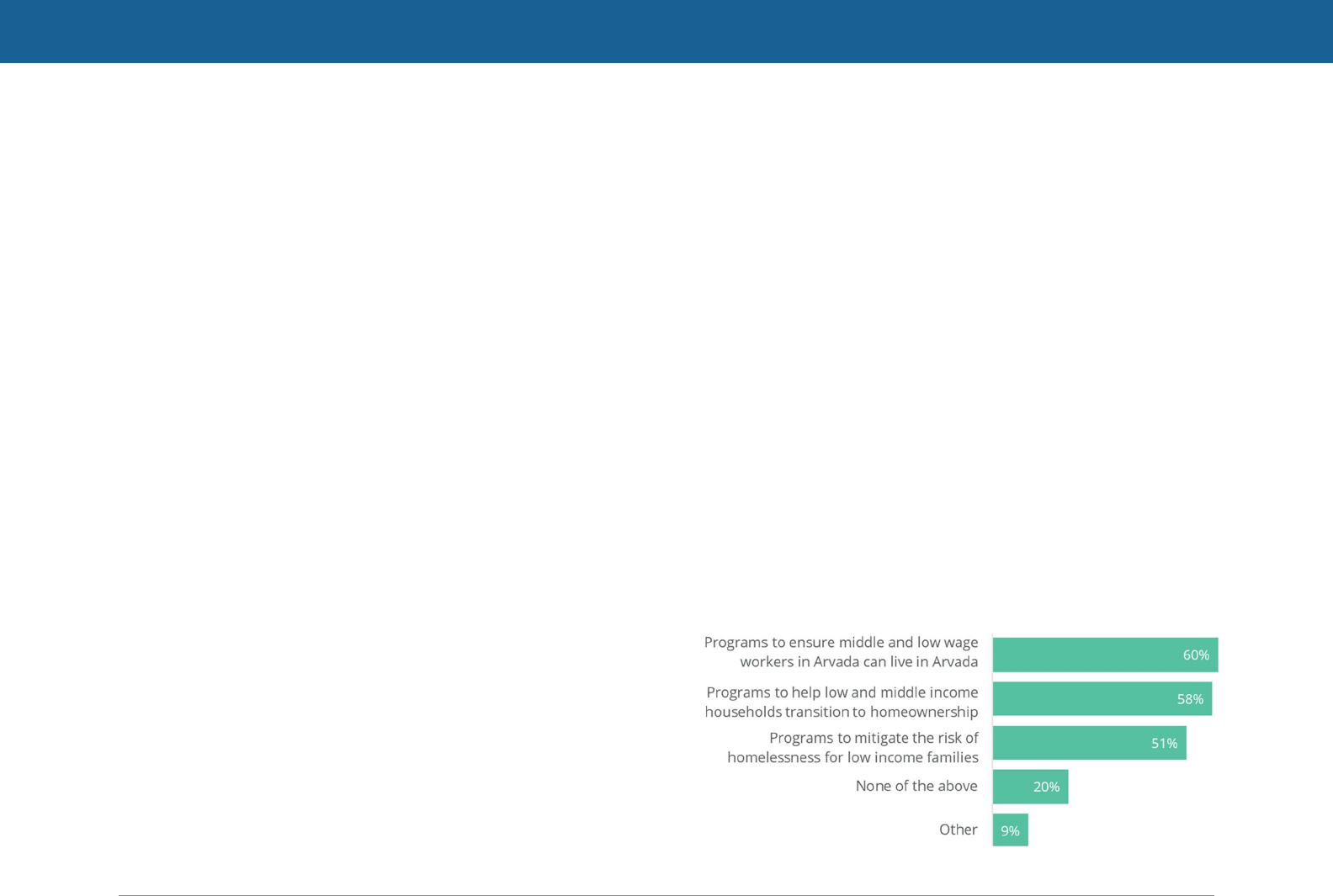
SUMMARY OF HOUSING NEEDS & COMMUNITY INPUT
ROOT POLICY RESEARCH ARVADA HOUSING STRATEGIC PLAN, PAGE 6
Thirty-eight percent (38%) of renters have incomes between
50% and 120% of AMI—a range that historically would have
placed them in consideration for first-time home purchase.
However, only 6% of homes sold in Arvada in 2022 were in an
attainable price-range for this group. Instead, potential buyers
do not see proportional affordability in the market unless they
have incomes over 150% AMI.
This creates affordability challenges for Arvada’s workers: only
8 of the 19 industries in Arvada have average wages high
enough to afford the median rent in Arvada and no industries
have average wages high enough to afford the median sale
price (even if they have 1.5 workers per household).
COMMUNITY PERSPECTIVES
Stakeholder interviews. A broad cross-section of
stakeholders, including social service providers, local employers,
community advocates, and real estate developers highlighted
growing housing needs in Arvada impacting economic
development, employee retention, and community well-being.
Social service providers emphasized the need for more
long-term programming to support low-income families
and residents experiencing (and at risk of) homelessness.
Real estate developers highlighted development barriers
including: high parking requirements; relatively high tap
fees and infrastructure costs; public opposition to multi-
family; requirements for conditional use permits in multi-
use zones; and slow approval processes. Addressing these
barriers and/or creating deeper affordability incentives
could boost housing production and affordability.
Resident survey. Arvada residents highly value housing
diversity/accessibility and affordability and a broad majority
(over 75% of surveyed residents) believe that housing forms
typically associated with affordability—such as duplexes,
townhomes, and apartments up to 3 stories along major
roads—are appropriate in Arvada.
Housing types rated most important to Arvada by survey
respondents are housing for middle class families;
affordable starter homes; accessible housing (e.g., no
stairs); and housing affordable to residents living on fixed
incomes and/or working in public service or retail.
Nearly half of residents think that duplexes and townhomes
specifically are appropriate in their own neighborhoods, with
support generally trending higher towards East Arvada.
Residents did express strong support for public investment in
housing—particularly for low and middle income workers as
well as programs to stabilize low-income families.
What types of housing programs should the City
of Arvada invest in over the next 5 years?
Source: Source: Root Policy Research from the 2023 Arvada Housing Survey.
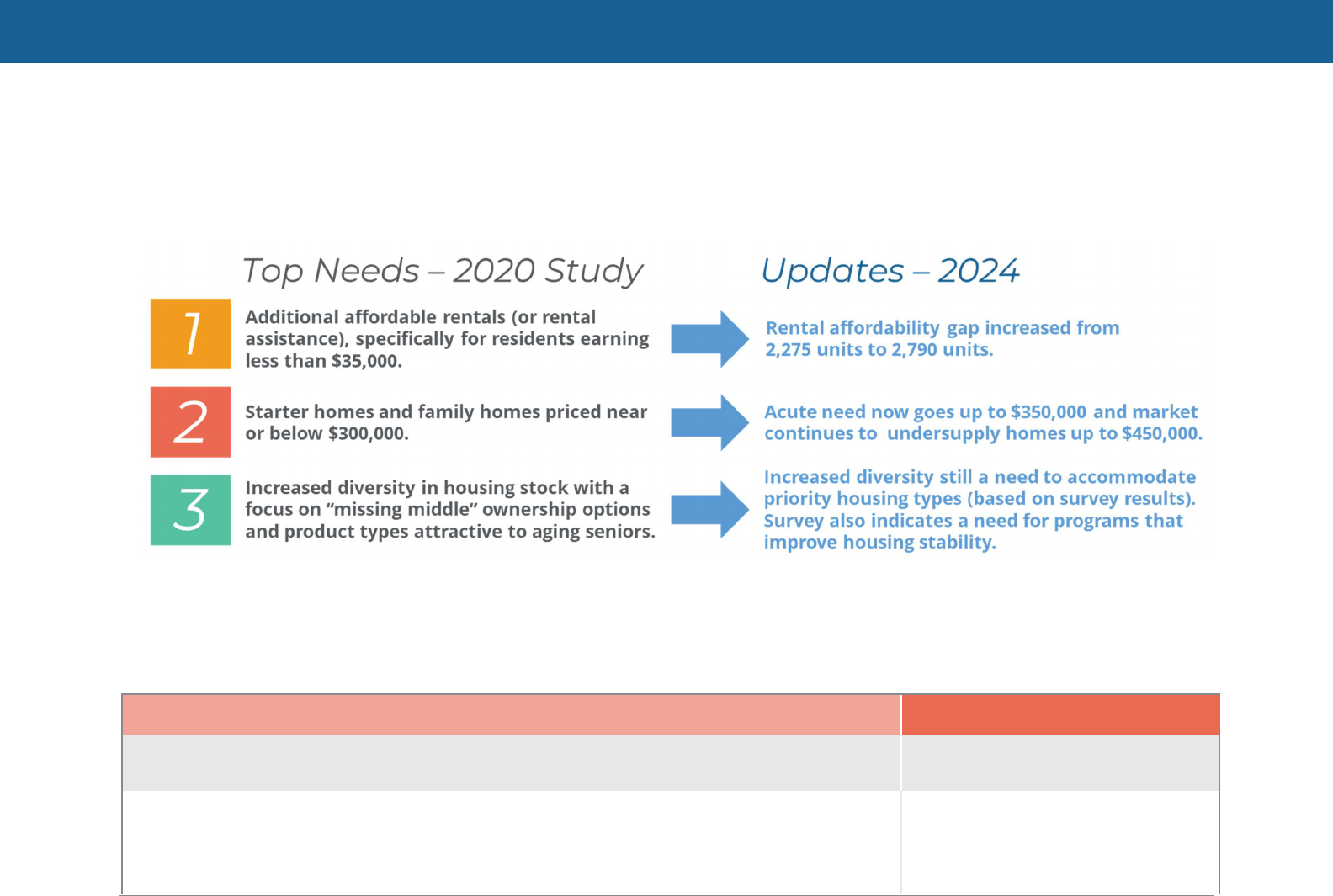
PROGRESS TO DATE ON 2020 STRATEGIES
ROOT POLICY RESEARCH ARVADA HOUSING STRATEGIC PLAN, PAGE 7
HAVE NEEDS CHANGED SINCE 2020?
The top needs identified in the 2020 Housing Needs Assessment are still present: affordable rental and ownership options and
increased housing diversity. Survey results also indicate a need for programs that improve housing stability coupled with support for
City investments in housing for low- and middle-income workers.
WHAT PROGRESS HAS BEEN MADE TO ADDRESS NEEDS SINCE 2020?
The 2020 Housing Needs Assessment and Strategy identified six priority strategies and related action steps to address the identified
needs at that time. The figure below shows the 2020 Strategy and Action Steps and summarizes the progress the City has made on
each strategy (as of March 2024).
2020 Strategy and Action Steps Progress to Date
1.
Establish a committee to implement the city’s affordable housing action plan and
support affordable housing development.
HAC was formed in 2023 and meets
quarterly.
2. Incorporate additional development incentives to the city’s land development code. Arvada’s code now includes height
bonus incentives and a reduced
parking requirement for LIHTC
developments. Parking incentives
Arvada recently updated its land development code (adopted by City Council on 5/18/20) to
include a height bonus, fast-track review, and modification opportunities for affordable
development. Additional incentives could include:

PROGRESS TO DATE ON 2020 STRATEGIES
ROOT POLICY RESEARCH ARVADA HOUSING STRATEGIC PLAN, PAGE 8
2020 Strategy and Action Steps Progress to Date
Waive or reduce development fees (up to an amount) for affordable housing development.
have been utilized the most. The HAC
also established criteria for providing
gap financing to LIHTC as an
additional inventive.
Waive rezone requirements (or streamline process) for developments with deep affordability.
City to utilize CDBG, HODAG or other resources to fund off site infrastructure that a
development may need in return for affordable units.
3.
Allocate publicly owned land (and/or acquire vacant or underutilized properties) for
affordable and mixed-income housing.
The City has identified potential sites
and is actively meeting with partners.
Inventory existing public land (including land owned by the City, County, schools district, etc.)
and evaluate feasibility for residential development.
Establish partnership with local affordable developers and land trusts
Evaluate funding sources for land/property acquisition that could be utilized to create or
preserve affordable housing.
Actively watch for property and land to acquire to repurpose (could include vacant land,
underutilized commercial, and/or small naturally occurring affordable multifamily housing).
4. Implement a foreclosure/eviction prevention program.
Jefferson County administered
emergency assistance during the
pandemic but the program does not
have ongoing funding. Housing
counseling is currently available.
Identify potential non-profit partners to provide services.
Evaluate funding source options and feasibility of providing short-term emergency rent and
utilities assistance.
5. Establish a local funding source using commercial and/or residential linkage fees.
This was identified as a long-term
strategy in 2020 so action steps are
ongoing. There is still a need for
additional funding to support
affordable housing programs,
production, and preservation.
Evaluate political support for linkage fee option.
Consider and allocate staff resources for program compliance.
Conduct/contract a nexus study to investigate potential fee amounts and implement program.
6. Leverage existing resources to facilitate affordable housing development.
The City, in consultation with the HAC,
established procedures and priorities
for the Arvada Affordable Housing
Fund (AAHF). The City continues to
leverage state and federal resources
effectively and efficiently to serve low
and moderate income households.
Utilize current city resources for affordable housing development and preservation.
Analyze and configure current housing revenues.
Private Activity Bond procedures and priorities.
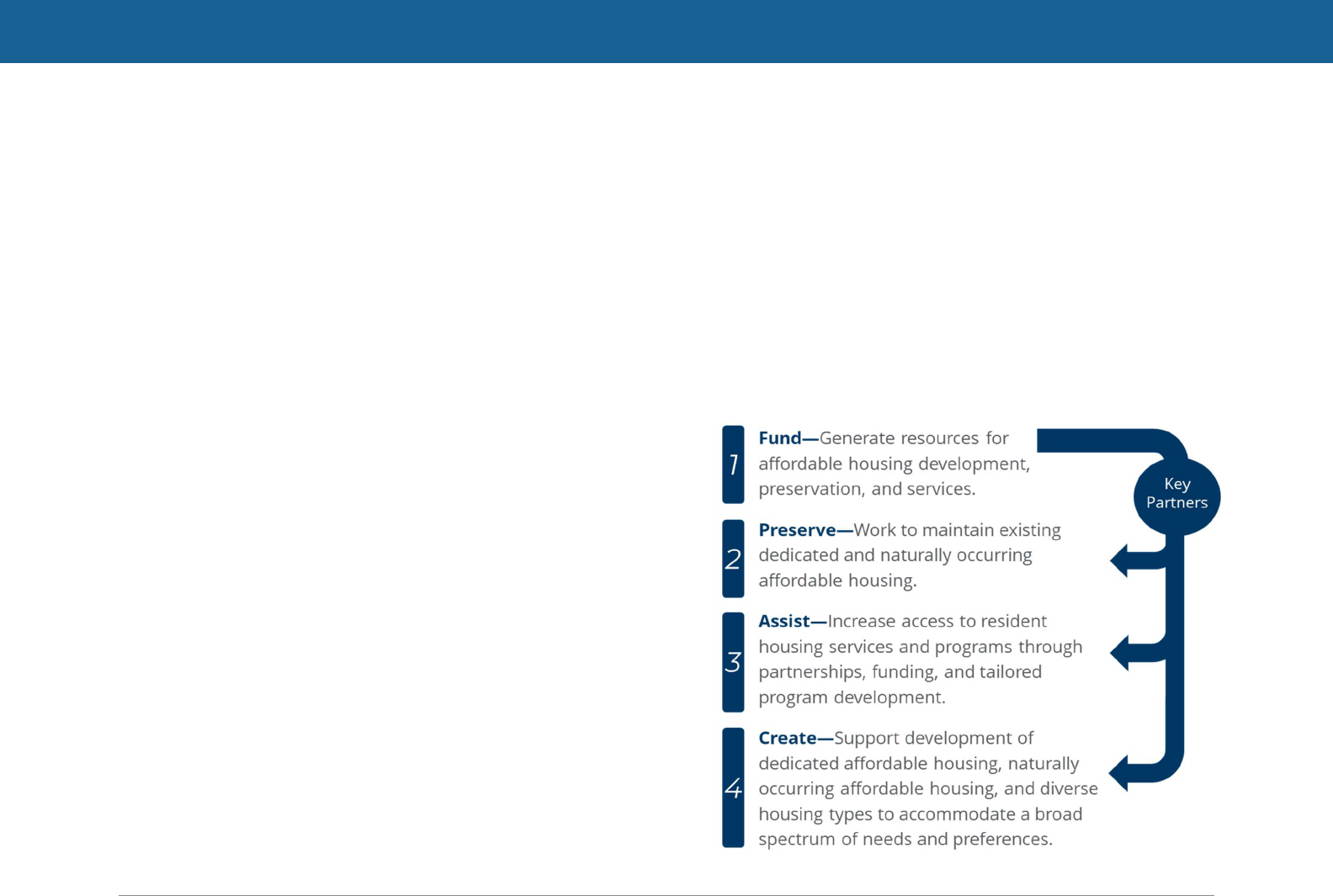
HOUSING GOALS & STRATEGY FRAMEWORK
ROOT POLICY RESEARCH ARVADA HOUSING STRATEGIC PLAN, PAGE 9
HOUSING VISION
Arvada’s Comprehensive Plan (completed in 2014) outlines the
City’s vision for growth and change through 2034.
1
The Plan
includes the following goals for neighborhoods and housing:
Plan for a range of neighborhoods and accessible housing
of different tenure types to accommodate diverse incomes
and all ages and abilities.
Encourage development of Workforce, Affordable, and
assisted housing throughout Arvada.
Maintain and improve the quality of the existing housing
stock in Arvada and revitalize the physical and social fabric
of neighborhoods that are in decline.
Provide opportunities for special needs and senior housing
in Arvada.
HOUSING GOALS
In addition to the stated vision for housing in Arvada, the City
set the following goals to measure outcomes:
Increase Affordable Housing inventory by 3% per year—139
units annually from the current baseline—in compliance
with the City’s commitment with State Proposition 123
funding. (Affordable is defined a 60% of AMI for rental units
and 100% of AMI for for-sale units).
Increase production of housing that expands price-point
and product diversity in Arvada, including multifamily and
1
An update to the Comprehensive Plan is planned for 2025 (pending budget
allocation) and will incorporate the 2024 Housing Strategy.
“missing middle” products (e.g., du-/ tri-/quad-plexes and
townhomes) that tend to have more attainable price-points.
STRATEGY FRAMEWORK
There is no single strategy—or “silver bullet”—to resolve a
community’s housing challenges. Instead, it is important to
have a toolkit of strategies to effectively address needs and
respond to changing market and policy conditions.
An integrated approach that creates funding and leverages key
partners to create and preserve affordability as well as assist
low-income households will have the most success.
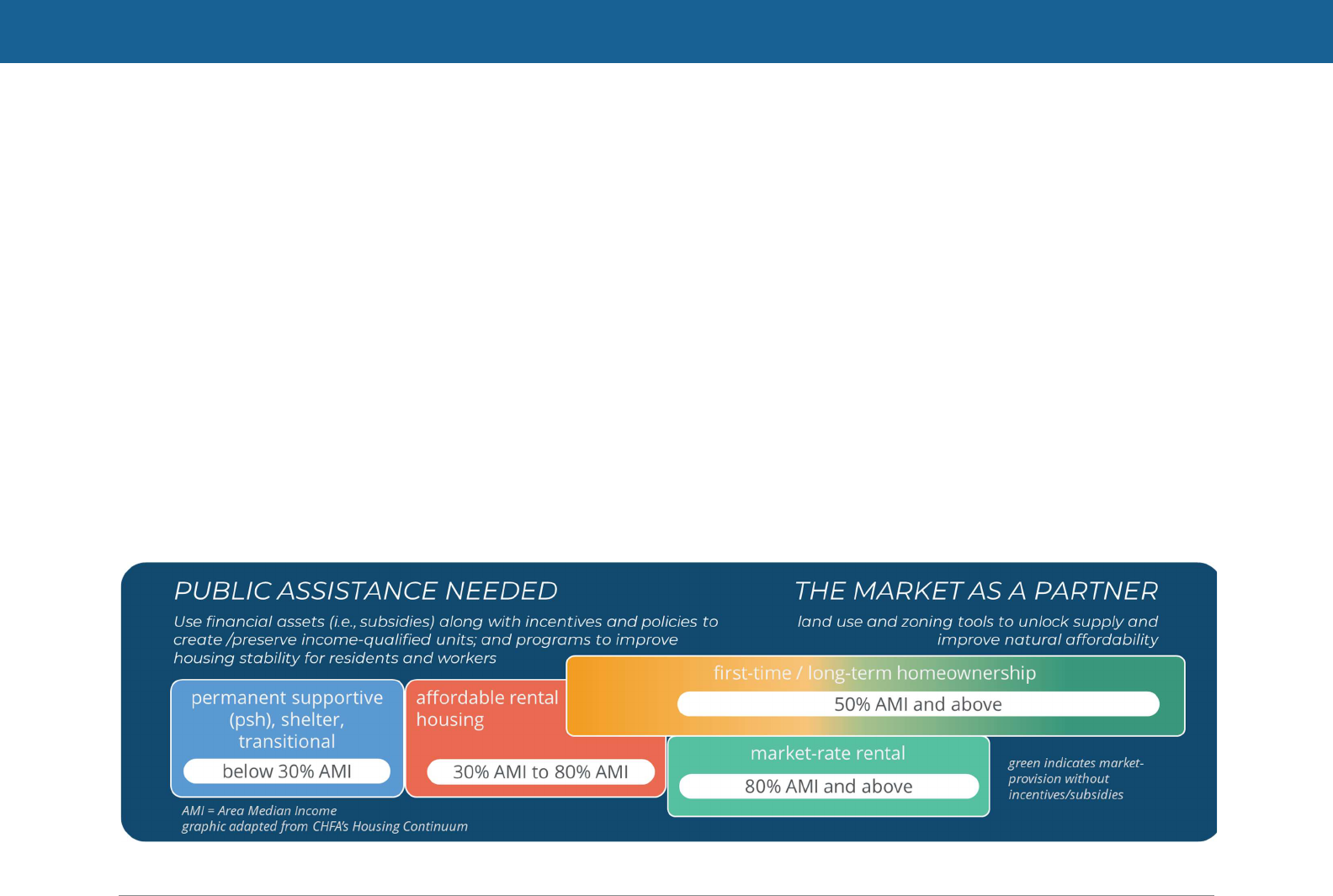
HOUSING GOALS & STRATEGY FRAMEWORK
ROOT POLICY RESEARCH ARVADA HOUSING STRATEGIC PLAN, PAGE 10
CITY OF ARVADA’S ROLE ACROSS THE HOUSING CONTINUUM
The graphic below shows the full spectrum of housing from
transitional/shelter housing up through market-rate
homeownership. Not surprisingly, the farther up the
income/price spectrum, the more likely it is that the private
market can provide housing without any subsidy or
intervention from public entities. However, at the most
affordable end (housing below 30% AMI), deep subsidies are
needed to produce and operate housing.
The City can leverage the market as a partner to develop
needed housing at the upper end by using land use and zoning
tools to unlock supply and increase natural affordability. (Land
use and zoning policies manage the type, volume, and location
of housing that can be constructed in a community, which
directly impacts product and price-point diversity).
Even with adequate zoning, the private market cannot
produce an adequate amount of affordable housing for
lower income households due to the high (and rising) cost of
new construction, land, and financing. Therefore, direct
subsidies (e.g., gap financing, LIHTC, land donations, etc.) are
needed to create affordable rental housing and to create access
to homeownership for low- and moderate-income households.
The two primary policy “levers” available to the City to
address needs across the housing continuum are:
1) Financial assets—funding and/or land assets—to
subsidize housing production, preservation, and programs.
2) Zoning tools to unlock supply, improve natural
affordability, and incentivize affordable/attainable projects.
Source: CHFA Housing Continuum graphic, adapted by Root Policy Research
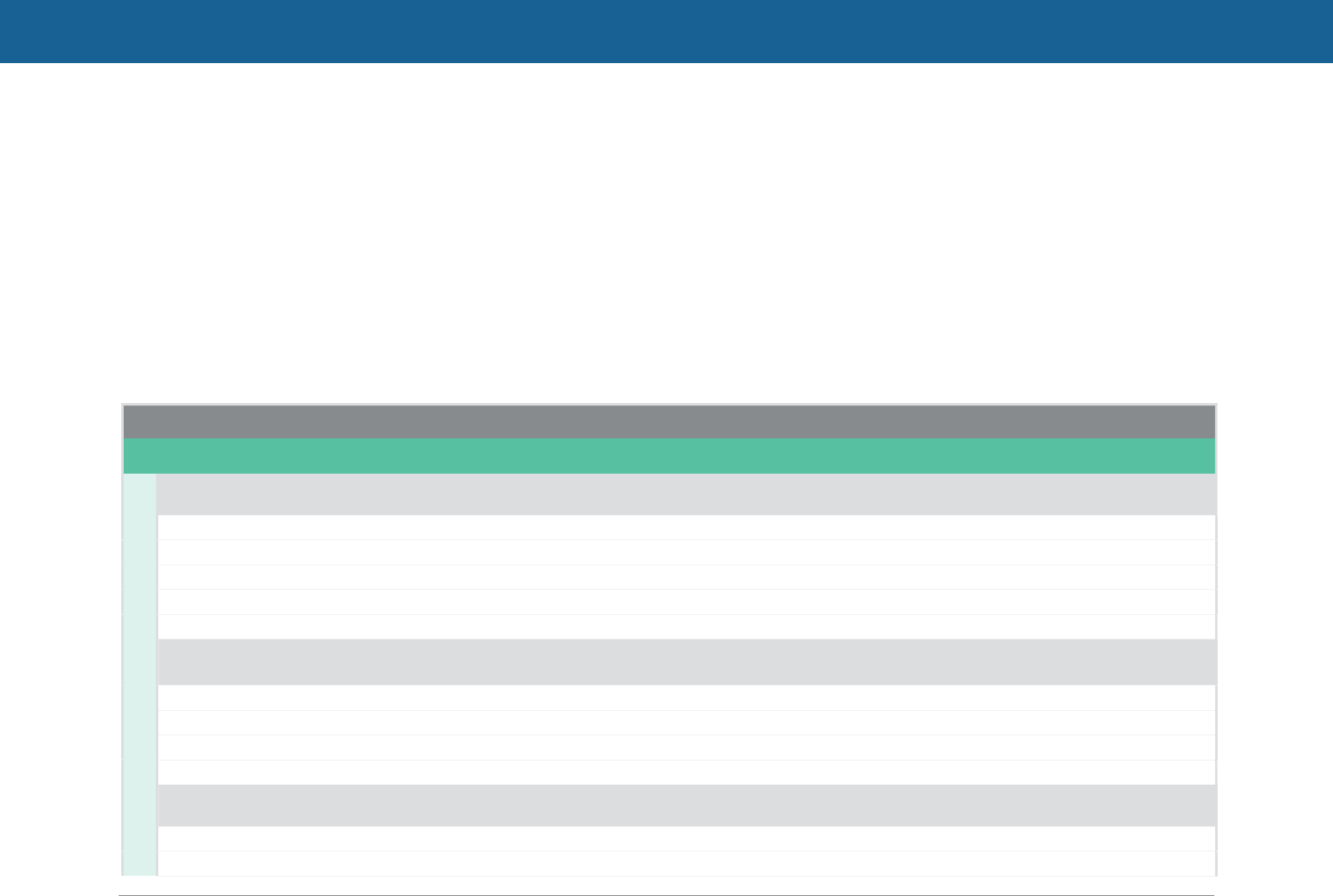
2024 HOUSING STRATEGIES & ACTIONS
ROOT POLICY RESEARCH ARVADA HOUSING STRATEGIC PLAN, PAGE 11
RECOMMENDED STRATEGIES AND ACTIONS
Recommendations for the City of Arvada were developed in conjunction with Arvada City staff, City Council, and the Arvada Housing
Advisory Committee (HAC). Strategies and action items are grounded in evidence-based best practices, Root Policy Research’s
expertise (including working with peer communities), and input from Arvada residents and stakeholders as part of the community
engagement conducted in support of the Housing Needs Assessment and Strategic Plan.
The figure below summarizes the housing strategies recommended for Arvada along with action steps to facilitate implementation
and level of priority (based on feedback from the HAC and City staff). Additional details on each strategy follow. The recommended
strategies are intended to provide Arvada with a “roadmap” to meet affordability needs and goals. Given Colorado’s legislative housing
priorities, Arvada should monitor state legislation that may impact prospective land use and zoning opportunities, as well as
requirements related to housing and adjust the Strategic Plan if/as needed.
POLICY, STRATEGY, AND ACTION STATUS PRIORITY DIFFICULTY
IMPACT
Policy Lever 1. Leverage financial assets to support affordable housing production, preservation, and programs.
Bolster Resources
1.
Continue existing program funding supported by federal and state funds
and service delivery partnerships.
CONTINUE MODERATE LOW MODERATE
-
Continue to support housing, community development, and homeless prevention/intervention strategies with CDBG funds.
-
Continue to apply for state funding (e.g., Prop 123 programs) as opportunities arise.
-
Advocate for additional federal and state funds dedicated to housing.
-
Continue ongoing evaluation to determine which programs and service delivery partnerships can be expanded.
-
Continue to evaluate efficacy of programs and align funding priorities in consultation with the HAC.
2. Continue to allocate publicly owned land (and/or acquire properties) for
affordable and mixed-income housing.
EXPAND HIGH
LOW -
MODERATE
MODERATE
- HIGH
-
Inventory existing publicly available land and study the feasibility of residential development.
-
Define land bank program and strategies/priorities for disposition (e.g., donations, discounted sales, and/or long-term ground leases).
-
Establish partnerships with other mission-driven or community-oriented landowners.
-
Actively watch for property and land in Arvada and Jefferson County to acquire and redevelop (contingent on additional funding).
3.
Create a dedicated, sustainable revenue source to support the underfunded
Arvada Affordable Housing Fund (AAHF).
NEW HIGH HIGH HIGH
-
Consider the feasibility and impact of a small sales or property tax increase.
-
Task the HAC to study potential local funding tools and determine the most appropriate source of funds for the City (e.g., taxes, fees, TIF).

2024 HOUSING STRATEGIES & ACTIONS
ROOT POLICY RESEARCH ARVADA HOUSING STRATEGIC PLAN, PAGE 12
POLICY, STRATEGY, AND ACTION STATUS PRIORITY DIFFICULTY
IMPACT
-
Evaluate funding streams for housing projects in peer cities/communities.
-
Determine concrete priorities for the fund.
Deploy Resources
4.
Invest in the production of income-restricted housing, prioritizing projects
that meet identified housing needs.
EXPAND MODERATE MODERATE HIGH
-
Continue to set annual priorities through the HAC for funding criteria.
-
Contingent on Strategy 3, dedicate local funds for income-restricted projects that align with the housing needs.
-
Conduct regular data updates for the HNA to align affordable housing priorities with changing needs.
5.
Invest in the preservation of affordable housing, including naturally
occurring affordable housing (NOAH) and properties with expiring
affordability contracts.
NEW HIGH MODERATE MODERATE
-
Continue to maintain a database of Arvada’s affordable housing properties.
-
Establish partnerships to acquire expiring income-restricted properties and units.
-
Contingent on Strategy 3, dedicate local funds to support acquisition/rehabilitation that renews affordability contracts.
-
Include housing acquisition/rehabilitation of NOAH as an eligible activity for AAHF applications.
-
Determine geographic and housing priorities for acquisition and rehabilitation.
-
Work with peer communities to understand existing preservation programs and evaluate the feasibility in Arvada (e.g., Wheat Ridge).
6.
Bolster implementation and coordination capacity in support of the
Housing Strategic Plan
EXPAND MODERATE LOW MODERATE
-
Evaluate staffing needs for effective implementation of action items and add capacity accordingly.
-
Foster partnerships and advocacy to support housing outcomes.
Policy Lever 2. Implement land use and zoning modifications to unlock supply, improve natural affordability and housing
diversity, and to incentivize affordable projects.
Incentives
7.
Incorporate additional incentives for affordable (income restricted)
developments.
EXPAND HIGH LOW MODERATE
- Create “fast-track” process for affordable (already a requirement of Prop 123)
- Update the “Affordable” definition in in the LDC to include affordable for-sale
-
Consider deeper parking reductions for affordable multi-family and add parking reduction for affordable townhomes.
-
Consider administrative approval of affordable residential in mixed use zones (subject to ground-floor commercial space).
-
Consider design incentives/alternatives that reduce the impact of balcony and covered parking requirements.
-
Consider density bonuses for both multi-family and single-family Affordable projects

2024 HOUSING STRATEGIES & ACTIONS
ROOT POLICY RESEARCH ARVADA HOUSING STRATEGIC PLAN, PAGE 13
POLICY, STRATEGY, AND ACTION STATUS PRIORITY DIFFICULTY
IMPACT
Entitlements
8. Implement the Jeffco Housing Advocacy Steering Committee’s workforce
housing land use recommendations.
EXPAND HIGH MODERATE MODERATE
- Zone more land for multi-family.
- Allow more types of housing in single-family zones—especially duplexes.
- Lower minimum lot size for single-family.
- Increase lot coverage limits.
-
Allow conversion of commercial and office buildings to multi-family housing as appropriate.
Requirements
9.
Explore affordability requirements in new developments. NEW MODERATE HIGH HIGH
-
Continue HAC discussion of affordability requirement programs, evaluating their potential impact on housing needs as well as market
feasibility.
-
Monitor current and new inclusionary programs implemented throughout Colorado, particularly the Denver metro, and evaluate if
inclusionary requirements would be effective and appropriate in Arvada.
-
Consider a nexus study to investigate commercial and/or residential linkage fees as a dedicated source of funding.
Table Notes:
Status reflects whether the strategy is a continuation of prior efforts, an expansion of an existing program or policy, or a new approach to
address needs.
Priorities were determined by City staff and the HAC and are based on the expected impact of the strategy along with difficulty and cost of
implementation.
Difficulty reflects the level of challenge or cost associated with implementation. This could include financial cost, staffing cost and/or time,
and political cost or anticipated opposition.
Impact reflects the expected capacity of the strategy to address identified housing needs related to housing affordability, housing diversity,
and housing stability.
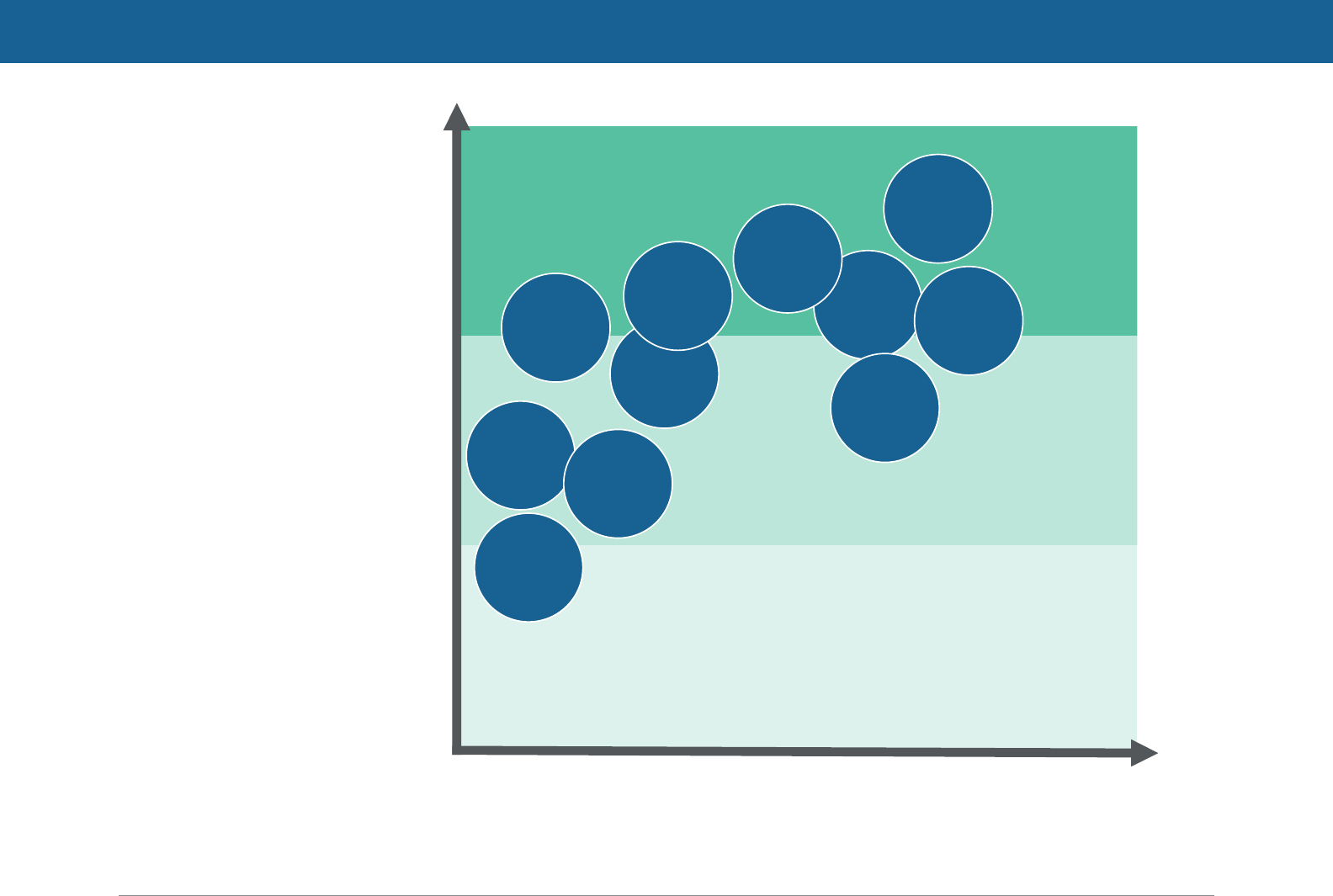
2024 HOUSING STRATEGIES & ACTIONS
ROOT POLICY RESEARCH ARVADA HOUSING STRATEGIC PLAN, PAGE 14
The figure at right plots
the recommended
strategies according to
their relative difficulty to
implement (i.e. financial
cost, political cost, or
staffing capacity/costs )
and anticipated impact on
housing affordability.
This matrix is intended as
a visual representation but
is not a perfectly precise
tool.
Note: *Impact of state legislation depends on the specific bill.
Source: Root Policy Research.
8. Land use
Changes
Difficulty (financial, political, and/or staffing cost)
Expected Impact (capacity to address needs)
1. Continue
Program
Funding
7.
Affordable
Incentives
2a. Public
Land
Donation
2b. Land
Acquisition
4. Produce
Affordable
9.
Affordability
Require-
ments
6. Bolster
Implement-
ation
Capacity
3. Fund the
AAHF
5. Preserve
NOAH &
Affordable
Monitor
State
legislation*

2024 HOUSING STRATEGIES & ACTIONS
ROOT POLICY RESEARCH ARVADA HOUSING STRATEGIC PLAN, PAGE 15
POLICY LEVER 1. LEVERAGE FINANCIAL ASSETS TO SUPPORT AFFORDABLE
HOUSING PRODUCTION, PRESERVATION, AND PROGRAMS
Financial assets (including funds and publicly owned land) are
commonly used by local governments to support affordable
housing production, preservation, and programs. Due to its
relatively low cashflow, and inability to leverage significant
permanent debt, income restricted housing almost always
requires some type of financial subsidy—either cash or in
kind—in order to be constructed. In high-cost markets, such as
the Denver Metro, federal subsidies alone are insufficient and
projects generally require local, state, or philanthropic funds.
Cities often leverage existing assets to subsidize affordable
housing projects, support existing programs and services, and
provide financial incentives in exchange for income-restricted
units. Communities can proactively address needs by
strategically planning for changing housing needs by identifying
additional financial resources and assets (for example, new
dedicated and sustainable revenue streams for projects).
Currently, financial resources to address housing affordability
needs in Arvada are drawn from federal and state sources, but
do not have a dedicated local revenue source such as a tax
dedication, linkage fee or a line item in the General Fund’s
budget. As it stands, these sources are insufficient to fully
address the housing needs identified in the 2024 HNA.
The City of Arvada receives about $450,000 annually in
Community Development Block Grants (CDBG) from the
HUD. Over the past five years, Arvada has used its CDBG
allocation to create mixed-income units, seniors-only
developments, affordable ownership housing, and
permanent supportive housing (PSH) units. The City has
also used CDBG funds to implement rehabilitation
programs for seniors and people with disabilities.
The Arvada Housing Authority administers federally funded
housing vouchers through the Housing Choice Voucher
Program and the Project Based Voucher Program.
The City may also apply for state-funded programs to
support affordable housing projects and services in
addition to (or combined with) federal funds. For example,
the City has also “opted in” to Proposition 123 programs,
which creates an opportunity for additional funds if
affordable production goals are met.
Arvada also receives Private Activity Bond allocations (PABs)
that can be used as a powerful financing tool for affordable
construction. PABs sufficient to cover 50% of a project’s
construction costs are federally required to unlock an
affordable project’s ability to access LIHTC. In these
projects, the credits can account for tens of millions of
dollars in the permanent Capital Stack. Because of the
pairing of PABs to LIHTC, affordable housing offers the
strongest leveraging for this financial resource.
At the local level, funds for affordable housing production
are limited though there are several opportunities for

2024 HOUSING STRATEGIES & ACTIONS
ROOT POLICY RESEARCH ARVADA HOUSING STRATEGIC PLAN, PAGE 16
Arvada to institute new dedicated funding streams for
housing (see Strategy 3). Currently, Arvada has no dedicated
local funding source to support the Arvada Affordable
Housing Fund (AAHF) and/or development projects.
Leveraging existing assets is critical to maintaining the ongoing
housing strategies of the City. Creating a dedicated and flexible
source of housing funds would substantially expand the City’s
ability to drive implementation of this Housing Strategic Plan
and make additional progress on the City’s housing goals.
Strategies 1 through 6, detailed below, outline actions the City
of Arvada can take to leverage financial assets to support
affordable housing production, preservation, and programs.
The first three strategies focus on stewarding and developing
assets while Strategies 4-6 focus on utilizing those assets.
STRATEGY 1. CONTINUE EXISTING
PROGRAM FUNDING SUPPORTED BY
FEDERAL AND STATE FUNDS AND
SERVICE DELIVERY PARTNERSHIPS.
Arvada allocates CDBG funds (and state funds as available) to
support housing programs, as well as nonprofits and service
agencies that provide housing, housing services, and/or
services to support low- and middle-income households. CDBG
Funds are allocated according to federal regulations. Any other
funding in Arvada flows through the Arvada Affordable Housing
Fund (AAHF), which is managed by the City, in consultation with
the HAC. In 2023, the HAC established procedures and priorities
for the Fund, which are revisited annually.
Program funds and partnerships are crucial for the City to
address residents’ current and future affordability needs. As
such, Arvada will need to continue existing program funding
(supported by federal/state funds) for programs and service
delivery partnerships to meet changing needs.
In addition to managing existing resources, the City could
advocate for additional federal and state funds dedicated to
housing. Advocacy could be a regional or countywide effort.
Service delivery partnerships can be maintained (and
strengthened) by participating in ad hoc meetings and
discussions and/or regional policy and action groups.
Recommended actions for Arvada:
Continue to support housing and community development
programs, homeless prevention/intervention strategies,
and other efforts to increase housing stability with the City’s
CDBG allocation.
Continue to apply for state funding (e.g., Prop 123
programs) as opportunities arise. Monitor new programs
and legislation that could create opportunities.
Advocate for additional state/federal housing funds and
explore opportunities to apply for state/federal allocations
(e.g., HOME funds).
Continue ongoing evaluation to determine which programs
and service delivery partnerships can be expanded.
Continue to evaluate efficacy of programs and align funding
priorities in consultation with the HAC.

2024 HOUSING STRATEGIES & ACTIONS
ROOT POLICY RESEARCH ARVADA HOUSING STRATEGIC PLAN, PAGE 17
STRATEGY 2. CONTINUE TO ALLOCATE
PUBLICLY OWNED LAND (AND/OR
ACQUIRE VACANT OR UNDERUTILIZED
PROPERTIES) FOR AFFORDABLE AND
MIXED-INCOME HOUSING.
Property acquisition costs are a central component of the cost
of developing affordable housing. Arvada and other public
entities (e.g., school district, RTD, and state entities) own
properties that could reduce costs and facilitate the production
of affordable and mixed-income units. Though much of this
property is already utilized for public facilities (or is
inappropriate for residential development), there are
opportunities for Arvada to create affordable and mixed-
income units through strategic utilization of publicly owned
property.
Many local governments donate, discount, or lease vacant land
or underutilized properties (e.g., closed schools, vacant or out-
of-date public sector offices) for residential mixed-income or
mixed-used developments through land bank/land donation
programs. Essentially, cities acquire properties which are held
in a “land bank” and redeveloped by nonprofit or private
developers. Land from the bank can be donated, discounted, or
offered on a land lease to the selected developer who agrees
to an affordability level or community benefit. This process is
typically started by creating an inventory of existing public land
that the City could use for future housing sites. Land banking
can also be used as a long-term preservation strategy, and a
mechanism to help develop additional financial assets for
future affordable housing needs.
Existing land inventory in Jefferson County presents a unique
opportunity for Arvada to reduce future development costs,
particularly given recent school closures across the county,
some of which could be redeveloped as housing.
Recommended actions for Arvada:
Inventory existing publicly available land (including land
owned by the City, County, Colorado, school districts, etc.)
and study the feasibility of residential development.
Implement a land bank/land donation program. (Banks can
vary in form from single parcels to scattered sites
properties to large tracts of land).
Establish partnerships with other mission-driven or
community-oriented landowners, such as school districts,
religious groups and churches, and nonprofit/affordable
developers.
Actively watch for property and land in Arvada and Jefferson
County to acquire and redevelop. This could include vacant
land, underutilized/vacant commercial, and/or small
naturally occurring affordable multi-family housing.

2024 HOUSING STRATEGIES & ACTIONS
ROOT POLICY RESEARCH ARVADA HOUSING STRATEGIC PLAN, PAGE 18
STRATEGY 3. CREATE A NEW DEDICATED,
SUSTAINABLE REVENUE SOURCE TO
SUPPORT THE AAHF.
Dedicated local funds for affordable housing production,
preservation, and programs (or a “Housing Trust Fund”) can
have a high impact on housing needs, especially in cities with
adopted housing plans, clear and measurable housing goals,
and/or additional development capacity. Revenue from local
sources vary widely but can include General Obligation Bonds,
commercial and/or residential linkage fees, sales tax, property
tax, general fund allocations, set-aside or cash-in-lieu from
inclusionary housing ordinances, and other taxes directly tied
to housing demand.
Local funds are particularly effective for affordable housing
development projects because they provide a sustainable and
flexible funding source without federal or state regulations. Fee
revenue can be used for gap financing of low-income housing
projects, land banking, development incentives or subsidies
(such as fee or tax rebates), and/or leveraging state and federal
funding that requires a local match.
In light of these benefits, the City recently created the Arvada
Affordable Housing Fund (“AAHF”) to support affordable
developers and provide gap financing for affordable and
attainable housing projects. Distribution of funds from the
AAHF are set annually by the HAC in alignment with this
Strategic Plan.
However, the AAHF is underfunded for its projected needs and
does not have a dedicated and sustainable revenue source.
Lack of revenue and funds make it increasingly difficult for
Arvada to meet its housing goals and address affordability
needs.
Recommended actions for Arvada:
Consider the feasibility and impact of a small sales or
property tax increase. (Over 25% of residents who
responded to the housing survey were supportive of a tax
increase up to $100/year to support the city’s affordable
housing fund).
Task the HAC to study potential local funding tools and
determine the most appropriate source of funds for the
City. Often, general fund allocations are the easiest way to
initiate housing trust funds but a dedicated stream is most
effective long-term. Options could include sales or property
taxes, linkage fees or inclusionary fees in lieu, tax increment
financing, or others.
Evaluate funding streams for housing projects in peer
cities/communities.
Determine concrete priorities for the fund—what programs
and policies should the fund support? Consider other
strategies and actions outlined in the Strategic Plan that
would require funding for maximum efficacy.

2024 HOUSING STRATEGIES & ACTIONS
ROOT POLICY RESEARCH ARVADA HOUSING STRATEGIC PLAN, PAGE 19
STRATEGY 4. INVEST IN THE PRODUCTION
OF INCOME-RESTRICTED HOUSING,
PRIORITIZING PROJECTS THAT MEET
IDENTIFIED HOUSING NEEDS.
Production of income-restricted (affordable) housing has
become increasingly important for many communities in
Colorado. As rents and home prices continue to rise, cities and
counties have strategically invested in the development of
income-restricted units for both renters and owners.
Investments are most effective in communities that have
recently completed housing needs assessments and/or
housing market analyses as these reports allow cities to
allocate their funds and resources in a manner that produces
maximum benefit for local communities.
In addition to data analyses, priority-setting is crucial for cities
to effectively address their community’s affordability needs.
Priorities should consider tenure (renter vs owner),
affordability levels (AMIs), geographic distribution (location in
the city as well as access to transportation, good schools, areas
of opportunity, etc.)
Recommended actions for Arvada:
Continue to set annual priorities through the HAC for
funding criteria (e.g., What renter/owner AMIs should be
targeted? Where should projects be sited? What financial
criteria must development projects meet for funding
eligibility?).
Contingent on Strategy 3, dedicate local funds from the
AAHF for income-restricted projects that align with the
housing needs detailed in Appendix A.
Conduct regular data updates for the Arvada Housing
Needs Assessment (every 3-5 years) to align affordable
housing priorities with changing needs.
STRATEGY 5. INVEST IN PRESERVATION
OF AFFORDABLE HOUSING, INCLUDING
NATURALLY OCCURRING AFFORDABLE
HOUSING AND PROPERITES WITH
EXPIRING AFFORDABILITY CONTRACTS.
There are two different submarkets of rental properties serving
low- and moderate-income households in Arvada: income-
restricted properties and naturally occurring affordable
housing, or NOAH. Preservation efforts are needed when the
affordability contracts on income-restricted units are set to
expire and when NOAH is under market pressure to raise rents
beyond what low-income households can afford.
Preservation is an attractive strategy because it utilizes existing
housing stock and is not bound by the timeline and cost of new
construction. However, preservation of NOAH, in particular, can
be a challenge because it is driven by market opportunities and
owned by private landlords—in other words, the City has no
control over the rents.
Expiring affordability contracts. Almost 400 rental units in
Arvada have federal subsidies contracts that will expire in the

2024 HOUSING STRATEGIES & ACTIONS
ROOT POLICY RESEARCH ARVADA HOUSING STRATEGIC PLAN, PAGE 20
next ten years and 1,200 units will expire in the next 15 years
(see Appendix A). This means that property owners will have
the option to convert units to market-rate housing. With rentals
in high demand, it is increasingly likely that affordability
contracts held by private companies (rather than non-profits)
will not be renewed after they expire—resulting in fewer
affordable units and more households vulnerable to
displacement/housing instability.
The most common form of preservation for expiring subsidies
is to provide funding to non-profits for acquisition (and
rehabilitation if needed) of the properties in exchange for long-
term affordability. Financial resources can be allocated for
activities including the identification of expiring properties,
outreach and education, and/or funds to incentivize
participation. The City does already institute a right-of-first-
offer on the sale of any property that previously received City
funding, putting them in an excellent position to preserve these
units as they “expire.”
Naturally occurring affordable housing. NOAH refers to
housing that does not have any income restriction but generally
serves lower- and middle-income households through
“naturally” affordable rents and home prices. It typically reflects
older apartments, smaller and attached for-sale homes, and/or
manufactured housing (i.e., mobile homes). This critical
segment of the market constitutes a large portion of the
housing stock but can be challenging to preserve through policy
tools because it is fully market-driven. NOAH preservation
strategies are typically designed to incentivize property owners
to institute long-term affordability periods by providing
financial assistance to make needed improvements to their
units and properties. Because these affordability restrictions
will reduce the overall market value of the property for the
duration of the restriction, the City must strike a balance
between short-term stabilization and long-term affordability
when considering the cost of these incentives.
Though they can be capital intensive depending on the context,
NOAH preservation strategies are flexible. For example, rental
properties can be maintained as rental or converted to
cooperative ownership; and ownership properties can be
resold to lower income families or leased as affordable rental
units. Programs can be structured as rehabilitation grants for
owners of existing multi-family developments (in exchange for
contractual affordability) and acquisition/rehabilitation
strategies can also support the conversion of hotels/motels into
affordable or transitional housing.
Preservation strategies—for both expiring affordability
contracts and NOAH—were recommended by the HAC as well
as key Arvada stakeholders. These efforts will not only prevent
housing instability and displacement among vulnerable
households but improve the condition of the city’s existing
housing stock and allow Arvada to adapt to changing housing
needs.
Recommended actions for Arvada:
Continue to maintain a database of Arvada’s income
restricted housing properties including affordability

2024 HOUSING STRATEGIES & ACTIONS
ROOT POLICY RESEARCH ARVADA HOUSING STRATEGIC PLAN, PAGE 21
periods, expiration timelines, ownership entities, and other
data to help City staff identify opportunities for
preservation programs.
Establish partnerships with local non-profits, housing
providers, affordable developers, and other entities who
could be able to acquire expiring income-restricted
properties and units.
Contingent on Strategy 3, dedicate local funds from the
AAHF to support acquisition/rehabilitation that renews
affordability contracts.
Include housing acquisition/rehabilitation of NOAH as an
eligible activity for AAHF applications (contingent on
imposing rent requirements).
Determine geographic and housing priorities for acquisition
and rehabilitation. For example, City staff could identify
which areas of Arvada require the most resources and/or
immediate intervention.
Work with the peer communities to understand existing
preservation programs (e.g., Wheat Ridge’s new program)
and evaluate the feasibility of a similar program in Arvada.
Continue to work across City departments to evaluate how
decisions in other areas may impact affordability of existing
housing stock (e.g., parks, fire, public works, etc.).
STRATEGY 6. BOLSTER IMPLEMENTATION
AND COORDINATION CAPACITY IN
SUPPORT OF THE STRATEGIC PLAN.
A number of the recommended strategies for Arvada include
expansion of existing policies or the addition of new
approaches to address housing needs. It goes without saying
that effective implementation will require staff resources to
manage policies and monitor progress. As specific policies are
implemented, the City should continue to monitor staffing
needs within the Housing Division and add capacity as needed.
Staff capacity and HAC engagement is also critical to continue
to foster partnerships with local service providers and
coordinate housing policy efforts with surrounding
communities, Jefferson County, and local foundations.
Recommended actions for Arvada:
Evaluate staffing needs for effective implementation of
action items and add capacity accordingly.
Foster partnerships and advocacy to support housing
outcomes.

2024 HOUSING STRATEGIES & ACTIONS
ROOT POLICY RESEARCH ARVADA HOUSING STRATEGIC PLAN, PAGE 22
POLICY LEVER 2. CONSIDER LAND USE AND ZONING MODIFICATIONS TO
UNLOCK SUPPLY, IMPROVE AFFORDABILITY AND HOUSING DIVERSITY, AND
INCENTIVIZE AFFORDABLE PROJECTS.
Land use and zoning reform (or modification) is a common
practice to increase housing supply, improve natural
affordability and housing diversity, and incentivize affordable
housing projects. While regulatory reforms cannot fully address
needs across the housing continuum, it is an important tool for
many local governments to increase production of income-
restricted units (through incentives or zoning mandates) while
also freeing the market to respond more effectively to product
and price-point demand.
Strategies specific to land use and zoning modifications are
detailed below and include:
Affordability incentives to increase income-restricted
production;
Land use recommendations that improve land use
efficiency and allow for more housing diversity in line with
market demand and housing needs; and
Exploration of requirements on new development to
contribute to the income-restricted housing supply through
unit production or impact fees.
A significant benefit of these types of regulatory reforms is
that they can typically be implemented without additional
financial resources—though they may require political
capital and/or staff capacity.
In addition to specific land use code modifications discussed in
the following strategies, Arvada also has an opportunity to
update its Comprehensive Plan, starting in 2025 (pending
budget allocation). The Comprehensive Plan should also
consider these recommendations in the context of the City’s
overall vision for growth and geographic priorities.
STRATEGY 7. INCORPORATE ADDITIONAL
INCENTIVES FOR AFFORDABLE (INCOME-
RESTRICTED) HOUSING DEVELOPMENTS.
In general, development incentives offer variances from
entitlement zoning (or relief from development fees) in
exchange for including affordable units in the development.
Incentives can take several forms:
Process-oriented development incentives, such as fast track
or administrative approvals, which indirectly lower
predevelopment costs by reducing risk, reducing redesigns,
and reducing the amount of time (and interest) a developer
will have to use bridge financing prior to closing.
Regulatory incentives that allow for more units to be built
than allowed by right by current zoning regulations (e.g.,
density or height bonuses), which improve land efficiency
and allow for more cost-efficient product.

2024 HOUSING STRATEGIES & ACTIONS
ROOT POLICY RESEARCH ARVADA HOUSING STRATEGIC PLAN, PAGE 23
Financial incentives, such as in-kind donations, fee
reductions/rebates or tax incentives for affordable
developments, which directly lower the cost of
construction.
Incentives can be used both to encourage market-rate
developers to include a small proportion of affordable units
and/or to improve the development economics and process for
projects with a large proportion of affordable units (e.g., LIHTC
developments). Most incentive policies mandate set asides of
between 10% and 30% of units affordable to 50% to 80% of the
AMI, depending on the City’s market. Affordability periods
range from 15 to 99 years (the average length of time for deed
restrictions is 30 years).
Arvada currently has some affordable incentives in place for
Low Income Housing Tax Credit (LIHTC) projects, including a 1-
story height bonus and parking reduction. However, there are
no codified incentives for affordable ownership projects or
projects funded through non-LIHTC sources.
Stakeholder outreach for the Housing Needs Assessment
identified some additional incentives that could help affordable
developers maximize their potential and that could stimulate
additional affordable development, outlined in the action steps
below.
Recommended actions for Arvada:
Create a “fast-track” development process for affordable
projects (a requirement of receiving funds from State
Proposition 123).
Update the “Affordable” definition to include an affordable
for-sale definition, defined by income-restrictions and AMIs
rather than LIHTC.
Consider deeper parking reductions for affordable multi-
family projects, including parking reductions for affordable
townhomes.
Consider administrative approvals for affordable
residential developments in mixed use zones, potentially
subject to ground-floor commercial spaces. (Often the
residents of the affordable development are the very
service workers needed by the onsite commercial space – a
true implementation of the live/work paradigm).
Consider design incentives or alternatives for affordable
projects that reduce the impact of balcony and covered
space requirements. For example, the City’s zoning code
could be modified to allow Juliette and/or faux balconies.
Consider density bonuses for both multi-family and single-
family affordable projects including (but not limited to) lot
size reductions, additional dwelling units per acre, and/or
incremental zoning (allowing the next increment of density).

2024 HOUSING STRATEGIES & ACTIONS
ROOT POLICY RESEARCH ARVADA HOUSING STRATEGIC PLAN, PAGE 24
STRATEGY 8. IMPLEMENT LAND USE
RECOMMENDATIONS FROM THE JEFFCO
HOUSING ADVOCACY STEERING
COMMITTEE ON WORKFORCE HOUSING.
The Colorado Gives Foundation, along with elected and
appointed officials, stakeholders, and other local actors formed
the Jefferson County Housing Advocacy Steering Committee to
develop workforce housing policy recommendations for local
jurisdictions throughout Jefferson County.
As part of this effort, committee members developed land use
and zoning reform recommendations to create more housing
price-point and/or product diversity in Jeffco cities. The Steering
Committee recommended all Jeffco communities:
Allow accessory dwelling units (ADUs) by right in
agricultural, single family, and two-family uses (subject to
lot and/or occupancy requirements).
Zone more land for multi-family.
Create opportunity for modular solutions through local
accommodations and state advocacy.
The Steering Committee recommended some communities
(depending on local context):
Allow more types of housing in single-family zones—
especially duplexes.
Allow medium density housing (10 dwellings per acre, or
du/a) in 10% of land area.
Allow administrative approvals of small multifamily or
affordable projects.
Lower minimum lot size for single-family.
Increase lot coverage limits.
Allow conversion of commercial and office buildings to
multi-family housing as appropriate.
Allow higher occupancy in each unit (accounting for multi-
generational households and expanding forms of
committed partnership and functional households).
Arvada already has some of these best practices in place,
including allowance of ADUs, reasonable occupancy limits, and
at least 10% of land zoned at 10 du/a or higher. However, there
are improvements the City can make to facilitate opportunities
for housing production that aligns with market demand and
improves natural affordability of market-rate products.
Recommended actions for Arvada:
Work with the Planning Department to draft and implement the
Jeffco Housing Advocacy Steering Committee’s
recommendations that are most applicable to the City of
Arvada, including:
Zone more land for multi-family;
Allow more housing types in single-family zones, especially
duplexes;
Lower minimum lot sizes for single-family homes;
Increase lot coverage limits;

2024 HOUSING STRATEGIES & ACTIONS
ROOT POLICY RESEARCH ARVADA HOUSING STRATEGIC PLAN, PAGE 25
Allow conversion of commercial and/or office buildings to
multi-family housing as appropriate; and
Regularly revisit ADU regulations and occupancy limits to
ensure the City is keeping with best practices.
STRATEGY 9. EVALUATE THE VIABILITY
AND IMPACT OF AFFORDABILITY
REQUIREMENTS IN NEW DEVELOPMENTS
SUCH AS INCLUSIONARY ZONING AND/OR
AFFORDABLE HOUSING LINKAGE FEES.
The primary policy tools used to mandate affordable housing
production in conjunction with new development are:
1. Mandatory inclusionary housing policies, which require
affordable production (or fees-in-lieu) in conjunction with
new residential development (note that these policies can
include incentives/offsets for compliance); and
2. Affordable housing linkage fees, which mandate an
impact fee on new development (residential, commercial,
or both) in proportion to its impact on affordable housing
needs.
Inclusionary ordinances are growing in popularity following
state legislation that enables these policies to apply to both
rental and for-sale developments. When structured well,
inclusionary zoning can generate a substantial number of units
at no direct cost to the city (other than enforcement and other
administrative costs). Inclusionary programs can include “off-
sets” and/or incentives for affordable housing provision, as well
as a fee “in lieu” option for developers. Cities that allow
developers to pay fees-in-lieu of developing income-restricted
units typically allocate revenue generated from the fees to
future affordable housing projects, but this is a challenging
strategy to maintain, given the high costs of land and
development.
Affordable housing linkage fees—similar to other impact fees—
are tied to quantifiable impacts of new development.
Implementation requires a nexus study to determine such
impacts before setting fees. Revenues from linkage fees must
be spent on affordable housing investments.
Since both inclusionary policies and linkage fees apply
exclusively to new development, they are most effective in
markets that are actively developing new housing and/or
commercial space and expect continued growth.
Recommended actions for Arvada:
Continue HAC discussion of potential affordability
requirement programs, evaluating their impact on housing
needs as well as market feasibility.
Monitor current and new inclusionary programs
implemented throughout Colorado, particularly the Denver
metro area, and evaluate if inclusionary requirements
would be effective and appropriate in Arvada.
Consider a nexus study to investigate commercial and/or
residential linkage fees as a dedicated source of funding.

2024 HOUSING STRATEGIES & ACTIONS
ROOT POLICY RESEARCH ARVADA HOUSING STRATEGIC PLAN, PAGE 26
MONITOR STATE LEGISLATION THAT MAY
IMPACT LAND USE AND ZONING
OPPORTUNITIES AND/OR REQUIREMENTS
RELATED TO HOUSING.
Given Colorado’s legislative housing priorities, Arvada (and
other communities in the Denver Metro area) should monitor
state legislation that may impact prospective land use and
zoning opportunities, as well as requirements related to
housing. Recent (2024) legislation proposed at the state level,
and applicable to the City of Arvada, includes: HB-1107, HB-
1304, and HB-1313 (among others).
As the 2024 legislative session closes—and after future
legislative sessions, City staff and the HAC should review the
Housing Strategic Plan in light of state legislative changes and
make adjustments if and as needed.
